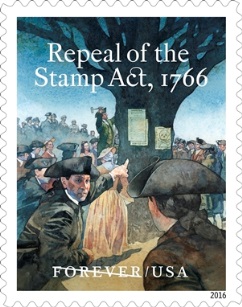
On March 18, 1766, exactly 250 years ago, after four months of widespread protest in America, the British Parliament repealed the Stamp Act, a taxation measure enacted to raise revenues for a standing British army in America. What better way to commemorate this occasion than with a United States Postal Service Forever stamp?
The Stamp Act was passed on March 22, 1765, leading to an uproar in the colonies over an issue that was to be a major cause of the Revolution: Taxation without representation. Enacted in November 1765, the controversial act forced colonists to buy a British stamp for every official document they obtained. Paper materials requiring the stamp included newspapers, pamphlets, legal documents, licenses, mortgages, contracts, and bills of sale. A stamp would be embossed on these papers to indicate payment.
The stamp itself displayed an image of a Tudor rose framed by the word “America” and the French phrase Honi soit qui mal y pense – “Shame to him who thinks evil of it.”
The colonists, who had convened the Stamp Act Congress in October 1765 to vocalize their opposition to the impending enactment, greeted the arrival of the stamps with outrage and violence. Most Americans called for a boycott of British goods, and some organized attacks on the customhouses and homes of tax collectors. After months of protest, and an appeal by Benjamin Franklin before the British House of Commons, Parliament voted to repeal the Stamp Act on March 18, 1766. However, the same day, Parliament passed the Declaratory Acts, asserting that the British government had free and total legislative power over the colonies.
The new U.S. stamp depicts a crowd gathered around a “liberty tree” to celebrate the repeal of the Stamp Act. The selvage area displays a proof print of a one-penny revenue stamp and includes a famous slogan from the era: “Taxation without representation is tyranny.” The stamp will be dedicated between May 28 and June 4 at the World Stamp Show to be held in New York at the Jacob Javits Center, and will be available thereafter in post offices.
Source: This Day in History and USPS.










